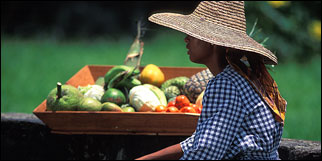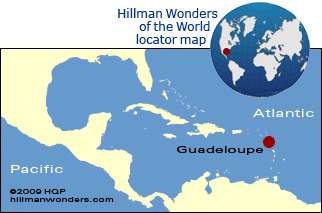Guadeloupe
 Why
Guadeloupe
is special
Why
Guadeloupe
is specialGuadeloupe is known for its French heritage and butterfly-shape island (see map below).
Guadeloupe tips & insights
Mispronunciation
I've heard travelers speak the Guadeloupe name with sort of a Spanish pronunciation. They add an extra syllable: gwa-dah-lou'-peh. The three-syllable French way is correct: gwohd'-ell-oop.
Major tourism activities
They include:
- Resorting
Most of the resorts are on the southern coast of Grand Terre island.
- Diving
Guadeloupe diving was praised by Jacques Cousteau. The best dive spots are on Basse-Terre island.
- Hiking
Basse-Terre has many interesting trails in the rainforest-covered mountains. There are waterfalls and wildlife to see. One trail takes you up to the top of La Soufriere volcano.
- Nightlife and dining
Nightlife is active but not jumping. Dining ranges from ordinary to fine. Both activities are centered in the bustling capital Pointe-a-Pitre and in the resort areas east of that city.
Guadeloupe's two main islands - Basse Terre and Grande Terre - sit side by side, separated only by a long, narrow channel. A drawbridge links them. When viewed from the air, the two islands together create the unmistakable shape of an open-winged butterfly.
History in brief
Christopher Columbus discovered Guadeloupe on his second voyage in 1493. The French settled it 142 years afterwards. Later the British took over. The flag switching continued. Today, Guadeloupe is a French Overseas Department.
Island statistics
More than 450,000 people live in Guadeloupe. About 800,000 people visit it each year (most are French).
Economy
Tourism and agriculture (especially bananas and sugar cane) are the main revenue sources.
Language
French is the official and main language of Guadeloupe. Creole comes in second. English is not that prevalent.
Location Map




